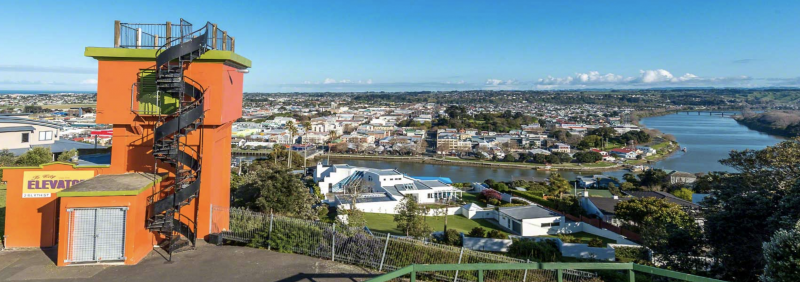Mainly following quiet country roads through farmland, this ride connects arty Whanganui and rural hub Hunterville, making for a picturesque and safer alternative to biking along busy state highways SH3 and SH1. It also a good way to link up the cycle routes of the Rangitīkei and Manawatu.
Passing through heartland Rangitīkei, the Three Rivers route traces historic stock routes as it winds its way north to the Volcanic Plateau. Highlights include Whanganui’s quirky Durie Hill elevator, tunnel and tower; and pretty rural scenes.
This trail links with the Mountains to Sea Cycle Trail at Whanganui, and is not far from the Gentle Annie and Manawatu Cycleway Heartland Rides, and the OTT (Ohakune–Taihape Trail) Connector Ride. As a standalone ride, the Three Rivers is best cycled from Hunterville to Whanganui, as it’s downhill overall.

Views over Whanganui from Durie Hill (Discover Whanganui)
This Connector Ride starts at the Whanganui i-SITE visitor centre beside the river on Taupo Quay. From there, head south long the riverside path and cross the bridge using the footpath. On the other side of the Whanganui River, just 10 metres to your left, is the entrance to the Durie Hill Underground Elevator ($2 coins only).
This Whanganui must-see was built over a century ago to provide residents of the garden suburb easier access to the growing city. As well as giving cyclists a shortcut up the hill, the tunnel and elevator are super-photogenic, and atop the hill are grand views over the city and river.
Step back in time in the Durie Hill Tunnel and Elevator
Note: If the elevator is closed, head up Anzac Parade for two blocks, turn right and follow Portal Street up towards the tower. Turn right onto Durie Street to get to the lookout.
After checking out the views from the elevator tower, ride down Blyth St and turn left to head out of town on Durie Street. Turn right at Portal Street, which becomes No 2 Line. This leads to Fordell, a small village with garage/dairy (13km from Whanganui).
Continue east on the main road (now called Kauangaroa Road). Just over a kilometre away is Denlair Road, the turnoff for Paloma Gardens – a series of themed gardens ($10 entry), plus accommodation. A detour here is worth the 3.5km side-trip that includes a short steep hill.
Back at the Denlair Road turn-off, the ride continues east along Kauangaroa Road and descends to the Whangaehu River (23km from Whanganui), before climbing back up over to the picturesque Turakina Valley (37km).
Around 40km from Whanganui is the Sutherland Puriri Reserve picnic area, accessed across a rickety old footbridge. Keep an eye out for tuī, shining cuckoo/pīpīwharauroa, kingfisher/kotare and NZ pigeon/kereru if you’re pit-stopping here.
From here the ride veers right up Mangatipona Road and then carries on past Mangahoe sheep station and the scenic Turakina Valley. At around the 54km mark, head right and follow Ongo Road into Hunterville (60km), world famous in New Zealand for its sheep sculptures and Huntaway dog statue. Here riders will also find cafes, pubs, accommodation and a small supermarket.
Thanks to the Kennett Brothers who supplied information from their Classic New Zealand Cycle Trails book and Tour Aotearoa Official Guide for this ride description.
ROAD CONDITIONS
This route follows sealed quiet country roads. Moderate traffic levels on the section between Whanganui and Fordell means riders should be confident cycling on narrow roads with other road users, and keep left at all times.
Between Fordell and Hunterville the roads are much quieter but riders should still be prepared to encounter quick-moving traffic at any time – the speed limit for most of this route is 100 km/h.
FITNESS & SKILLS
This is a grade-4 (advanced) cycle touring route that requires a moderate level of fitness.
TYPE OF BIKE
This ride could be tackled on a touring bike, gravel bike or road bike, however if you’re riding the route in reverse and continuing onto the Mangapurua section of the Mountains to Sea Cycle Trail, you’ll need a ship-shape mountain bike with all necessary spares and tools (and the mechanical skills to use them).
MAPS & NAVIGATION
These country roads are well signposted, but a map will prevent wrong turns, help you time your ride, and identify points of interest along the way.
WEATHER
It is possible to ride this route all year round. However, heavy rain and high winds can occur at any time of the year, and it can be frosty in the mornings in winter. A good raincoat, and warm clothing in winter, are essential.
ACCOMMODATION
A variety of hotel/motel/B&B/holiday park accommodation is available in Whanganui. Accommodation in Hunterville is more limited with a hotel, motel and a handful of holiday homes. En route, cute cottage and cabin-style accommodation is available at Paloma Gardens.
FOOD & WATER
Whanganui has a wide range of restaurants, cafes and supermarkets. Hunterville is serviced by cafes, pubs and a small supermarket. Drinks and snacks can be bought from the Fordell garage, approximately 14km from Whanganui, but other than that there are no shops en route. Riders should go well prepared.
Public toilets are available in Whanganui and Hunterville. Water can be topped up at the Fordell garage.
GETTING HERE
The Intercity bus network services both Whanganui and Hunterville.
This trail links with the Mountains to Sea Cycle Trail at Whanganui, and is not far from theGentle Annie and Manawatu Cycleway Heartland Rides, and the OTT (Ohakune–Taihape Trail) Connector Ride. As a standalone ride, the Three Rivers is best cycled from Hunterville to Whanganui, as it’s downhill overall.
CELLPHONE COVERAGE
There is cellphone coverage in and around Whanganui and Hunterville, but it is patchy along the route’s middle section.
TOILETS
There are public toilets in Whanganui and Hunterville.
VISITOR INFORMATION
Whanganui has an excellent i-SITE visitor centre, beside the river on Taupo Quay. In Hunterville, visitor information can be found in the Hunterville & District Settlers Museum on Bruce Street.

